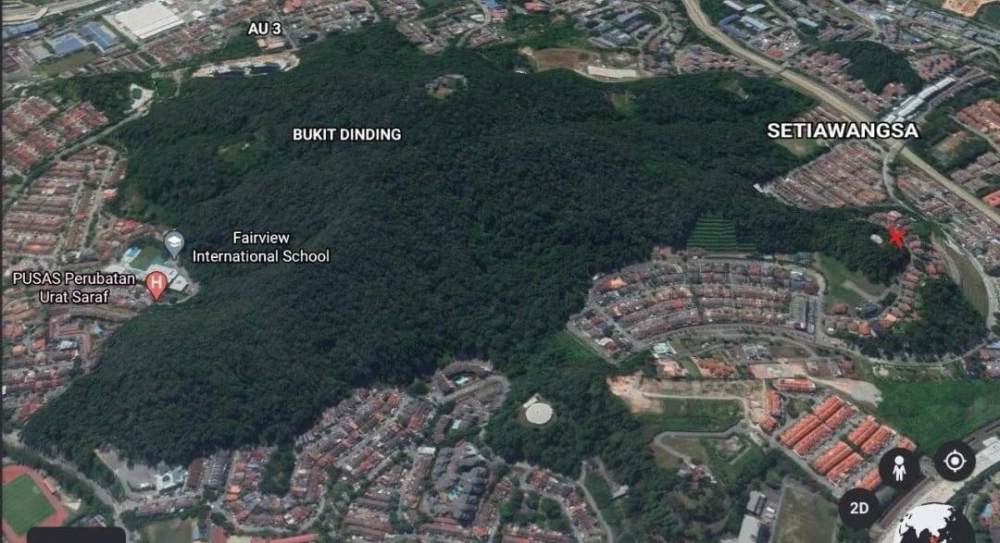KUALA LUMPUR, Sept 20 — Setiawangsa and Wangsa Maju residents are opposing a planned development along the foothill of Bukit Dinding, in a fight that has again cast the spotlight on the Kuala Lumpur City Hall’s (DBKL) vetting process.
Bukit Dinding, while just under 300 metres tall, is a popular spot for urban folks. But the lush hill — believed to be the tallest within city limits — is also known to be landslide-prone, according to homeowners whose homes dot the surrounding areas.
Since news about the development plan surfaced, hundreds of concerned residents have mounted a drive to pressure DBKL against allowing the project, worried that the development around the steep hill could worsen existing landslide problems.
“You recall Highland Towers? At that point, we all realised slope development is dangerous,” said a resident.
“Well, the developers are saying it’s safe and all that. As Setiawangsa residents, we’re not convinced at all. If you stay there, you’d know we’ve already dealt with several landslides. The bottom line is we don’t want the project there and we will fight,” the resident added.
Built on the slopes of steep hills around Taman Hillview, Ulu Klang, Selangor, Block 1 of the Highland Towers collapsed in December 1993 after a heavy downpour caused a major landslide. The tragedy killed 48 people.
Malay Mail understands that the Bukit Dinding development plan has already been approved by DBKL.
Residents have raised the alarm as to how an area with questionable slope stability can be sold to a private developer and green-lit for development.
Bukit Dinding was originally a plantation. Its owners later diversified into real estate development following a common business practice among large plantation companies to convert plantation land into housing and towns.
According to the Kuala Lumpur City Plan, large parts of Bukit Dinding have been designated for conservation, but the foothills have been zoned for “housing” even as early as the 80s.
Some residents that Malay Mail spoke to questioned the zoning rationale because it seems contradictory to the conservation effort.
They feel land clearing at the hill slopes can cause landslides, especially at a time when torrential rain has become more frequent.

Some have shared photos and video clips of what appeared to be soil erosion and flash floods that have happened around the area in the last few months. Malay Mail could not independently verify these events.
Based on the development’s advertisements, the project will involve 300 units of high-end apartments designated on six acres of parcel 2, Lot 26413, west of Bukit Dinding.
Some of the project will encroach into what looks like the designated “green zone”, where no development is supposed to occur, according to residents’ information.
Malay Mail was informed by Rimba Disclosure Project, a watchdog that tracks deforestation throughout the country, that the project could also be on slopes with gradients of over 30 per cent, much higher than the 20 per cent maximum threshold considered safe.
The planning approval was made on March 28 this year and land work approval was given just last month, on August 10.
The developer made an attempt to appease residents by holding a town hall meeting on September 15. About 70 residents attended a meeting that lasted more than two hours; nearly all are said to be against the proposal.
Malay Mail was not allowed into the meeting but managed to interview some of the attendees.
“We’re worried about traffic but our biggest concern is landslides, safety of the residents. Of course developers will always say it’s safe, but we want to hear what DBKL has to say,” said one of the residents, a retiree in her 60s who did not wish to be named.
Setiawangsa MP from PKR Nik Nazmi Nik Ahmad has taken up the case with DBKL, tweeting about residents’ concerns and following up with a request to meet officials from the city council.
One of his key demands is that DBKL provide thorough details about issues around safety and slope stability to the community there. The letter was sent on September 14.
“That is definitely the main concern of residents there,” the PKR lawmaker told Malay Mail.
DBKL could not be reached for comment at the time of writing.




















